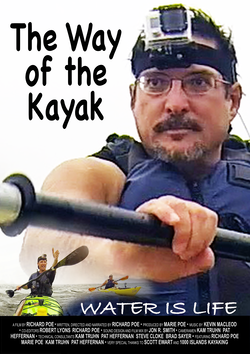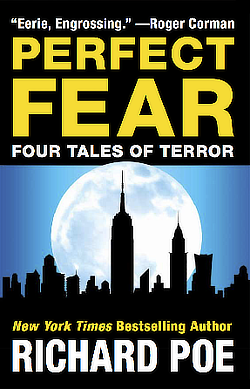PERFECT FEAR: AUTHOR INTERVIEW, PART 4
A Conversation with Richard Poe, Author of Perfect Fear
by Paul Germano (continued)
| « PREVIOUS PAGE | NEXT PAGE » |

FEARS, INHIBITIONS AND MENTAL BLOCKS
Germano: How did you end up at the Syracuse New Times?
Poe: I had to make a living. Hayden Carruth told me I should leave school and drive a truck. I never did that, but I worked as a waiter, a store clerk, a door-to-door salesman, a short-order cook, a telemarketer and a lot of other things. And it was killing me. My brain was atrophying. I wanted a real job, where I could use my writing skills. So I started doing newspaper work. Mickey Mercier was then a staff writer at the New Times. You remember Mickey! He got me a job at the New Times in January, 1984. That was my first job in journalism. I was 25 years old. And I never looked back. I spent the next 27 years working as a journalist and writing non-fiction books.
| POE: If I want to write horror, I have to immerse myself in horrific things. I have to watch scary movies, read scary books, and think scary thoughts, morning, noon and night. I have to put myself into a horror trance. | |
Germano: Did you keep writing horror through those years?
Poe: Yes, I kept writing fiction on the side, and, by the time I was in my mid-to-late ‘20s, I had pretty much zeroed in on horror fiction as my favorite genre. But that’s when I started running up against fears and inhibitions. Writing horror activated certain fears. I wrote two horror novels and many short stories, but I had trouble finishing those works. In the case of both horror novels, I wrote complete drafts, but couldn’t finish the final revisions. Both times, the fear kicked in, and I had to stop writing.
Germano: That’s sort of like giving up on the one-yard line. If you’d already written full drafts of these novels, why didn’t you push through and go for the touchdown?
Poe: It wasn’t really the one-yard line. It was more like the 20-yard line. And those last 20 yards were the hardest. Writing the first draft was easy. There’s nothing scary about the first draft. It’s the revision process that’s scary. That’s when I would add flesh to the bones. That’s when the characters would come alive, the emotions would stir, and the elements of terror would emerge from the story. That’s when my fears would begin surfacing.
Germano: You said earlier that the writing process itself would activate your fears. Can you describe how that happened?
Poe: Stephen King says that “writing is self-hypnosis,” that a writer must put himself into a kind of “trance.” I think that’s true. It applies to any kind of writing, not just horror. If I’m writing a self-help book on how to make money, I have to immerse myself in thoughts of money, money, money and nothing but money. If I want to write horror, I have to immerse myself in horrific things. I have to watch scary movies, read scary books, and think scary thoughts, morning, noon and night. I have to put myself into a horror trance. That’s where I ran into problems.
| POE: There’s a lot of autobiography in “Scotophobia.” … Up in Syracuse, I often felt isolated. … I moved down to the city, in large part, to escape that sense of isolation. But, like Frank [Romain], I discovered that… things can get very dark in the city. | |
Germano: What sorts of problems?
Poe: The worst time was with the second novel — my second horror novel, that is. I was living alone in this spooky railroad flat on St. Mark’s Place, in the East Village. And, as I got deeper and deeper into the horror mindset, I became increasingly fearful of the dark, and fearful of being alone in my apartment. One night, I got so scared that I had to leave my apartment. I went out and got a cup of coffee at an all-night diner on Second Avenue. So there I was at 3:30 in the morning, drinking coffee in a diner, and wondering how I’d be able to work the next day. At the time, I was a senior editor at SUCCESS magazine, which was a very demanding job. I couldn’t afford to lose sleep like this. So basically I had to choose between my horror novel and my job, and I chose my job. I couldn’t do both at the same time.
Germano: So it looks like there may be an autobiographical element in “Scotophobia.” Your character Frank Romain also lived in the East Village, and he was also scared of the dark.
Poe: There’s a lot of autobiography in “Scotophobia.” When I moved down to the city, I loved the crowds and the lights and the feeling that you were never alone. Up in Syracuse, I often felt isolated. I didn’t like the long winters, and I didn’t like the way everything closed up at night and the streets emptied out. So my experience was a lot like Frank Romain’s. I moved down to the city, in large part, to escape that sense of isolation. But, like Frank, I discovered that moving to the city is no cure-all. Things can get very dark in the city.
Germano: When did you have this experience of living on St. Mark’s Place and trying to write that horror novel?
Poe: That situation really came to a head in December of 1990. That’s when I finally had to give up writing the novel. Shortly afterwards, I went to a party at the apartment of a dear friend, Nina Zivancevic, who is a gifted poet and novelist from the former Yugoslavia. By the way, this is the same Nina who wrote the Foreword to Perfect Fear. At Nina’s party, I met one of her friends, a sculptor named David Hatchett. He was a very spiritually-minded guy, a student of kung fu. I told David about my problem writing this horror novel, and he advised me to go back and finish it. He told me that I needed to “ride that horse,” even if it cost me my sanity, because this is art, and art is more important than me. So he was basically telling me to martyr myself for this novel. There was something intriguing about his advice, but I didn’t act on it. Not then. I wasn’t ready yet.
| POE: My wife loved [“Scotophobia”] and wanted to pitch it for television. … I thought it needed more work. … Before we knew it, sixteen years had gone by… Finally… Marie said enough is enough, it’s time to pitch “Scotophobia” … I had the distinct feeling that, if I said no, she was going to put an ax through my head. So I said yes! | |
Germano: So you left that novel unfinished. How many other unfinished works do you have lying around?
Poe: Boxes and boxes. Two horror novels, in full draft form. Several other horror novels, only partially written. One non-horror novel which is fairly complete. Lots of poems. Many short stories.
THE MAKING OF PERFECT FEAR
Germano: What prompted you to write Perfect Fear?
Poe: I had already written “Scotophobia” back in 1995. My wife loved that story and wanted to pitch it for television. She’s a freelance TV producer, and she had good contacts in the industry. Among other things, Marie was the animation producer for the premier season of Beavis and Butt-Head. But I wouldn’t let her pitch “Scotophobia.” I thought it needed more work. So I just kept procrastinating and, before we knew it, sixteen years had gone by. Then finally, in 2011, Marie said enough is enough, it’s time to pitch “Scotophobia,” and no more excuses. I had the distinct feeling that, if I said no, she was going to put an ax through my head. So I said yes!
Germano: How did “Scotophobia” lead to Perfect Fear?
Poe: Once Marie made it clear that she was going to pitch “Scotophobia” whether I liked it or not, that forced me to act. I had to complete my final revisions on the story. And, once the revisions were done, I discovered, to my surprise, that I really liked “Scotophobia.” And suddenly I wanted to publish it. So I bundled it together with three other stories to make this anthology, Perfect Fear.
| GERMANO: How many other unfinished works do you have lying around?
POE: Boxes and boxes. Two horror novels, in full draft form. Several other horror novels, only partially written. One non-horror novel which is fairly complete. Lots of poems. Many short stories. |
|
Germano: So you left that novel unfinished. How many other unfinished works do you have lying around?
Poe: Boxes and boxes. Two horror novels, in full draft form. Several other horror novels, only partially written. One non-horror novel which is fairly complete. Lots of poems. Many short stories.
Germano: Where did the other three stories come from? Are they new?
Poe: Two of the stories are new. Those are “The Strange, White Room” and “The She-Wasp.” I wrote those in August and September of 2011. The other story, “Don’t Come Back, Mommy,” was partially written many years ago, but it was really just a sketch or a fragment. I decided to finish it for Perfect Fear.
Germano: How long did it take you to write Perfect Fear, from beginning to end?
Poe: Most of the writing and revision was done in a 10-week period, between August and November of 2011. Of course, I had already written “Scotophobia” in 1995, but it needed revision. So it was really in August of 2011 that I got serious about the work. That’s when I made the decision that I was going to publish a collection of stories, and that’s when I really got down to work.
Germano: You had failed so many times before, when you tried to write horror. What was different this time? Why were you able to finish Perfect Fear?
Poe: This book was an answer to prayer. When I started work on this book, in August, I consecrated the project to the Blessed Virgin Mary. I begged for her protection and guidance. And I believe she answered those prayers. As I began writing, all my old fears kicked in, but, this time, I overcame them and finished the work.
Reprinted from Perfect Fear (released by Heraklid Books, July 5, 2012)
| « PREVIOUS PAGE | NEXT PAGE » |







